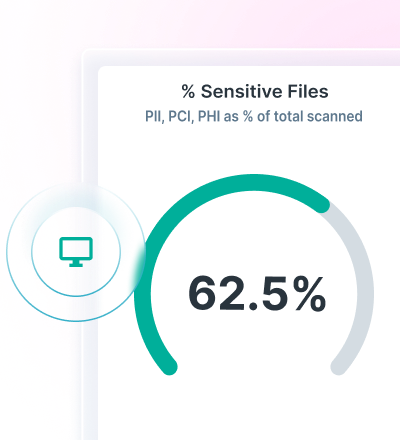Top 10 DSPM Vendors Compared: Choosing the Best DSPM Vendor
0 분 읽기

Tim Herr
Sensitive data has never been more distributed or difficult to control. As organizations expand across multi-cloud, SaaS and on-prem environments, visibility gaps multiply and new risks emerge. Traditional data protection tools were not designed for this level of complexity or scale.
Data Security Posture Management (DSPM) fills this gap by providing continuous visibility into where sensitive data resides, how it moves, who can access it and where exposure is growing. DSPM has become a critical capability for CISOs as the volume of unstructured data accelerates and AI systems introduce new risk pathways. Accordingly, choosing a DSPM solution is now a strategic decision with direct impact on compliance posture, cyber resilience and operational efficiency.
This guide compares the top DSPM vendors in the market and explains why Forcepoint DSPM delivers the most complete visibility and control across hybrid enterprises. It incorporates insights from analyst research including Gartner and IDC along with real-world best practices from global deployments.
To survey the top products currently on the market, read our guide to the best DSPM software of 2025.
Top 10 DSPM Vendors Overview
| Customizable AI/ML Classification | On-Prem & Hybrid Deployment Support | Granular File-Level Permissions Analysis | High-Fidelity Unstructured Data Hygiene | Depth of Privacy & Compliance Automation | DLP-Grade Labeling & Fingerprinting | |
|---|---|---|---|---|---|---|
| Forcepoint DSPM | 🟢 | 🟢 | 🟢 | 🟢 | 🟢 | 🟢 |
| Zscaler | 🔴 | 🔴 | 🟢 | 🟡 | 🟡 | 🟡 |
| Cyera | 🟡 | 🔴 | 🟢 | 🟡 | 🟢 | 🟡 |
| Rubrik | 🔴 | 🟢 | 🟢 | 🟢 | 🟡 | 🔴 |
| Palo Alto (Prisma) | 🔴 | 🔴 | 🟢 | 🟡 | 🟡 | 🟢 |
| BigID | 🟡 | 🟢 | 🟢 | 🟢 | 🟢 | 🟡 |
| Netskope | 🔴 | 🔴 | 🟢 | 🟡 | 🟡 | 🔴 |
| Varonis | 🟡 | 🟢 | 🟢 | 🟢 | 🟢 | 🟢 |
| Securiti | 🟡 | 🟡 | 🟢 | 🟢 | 🟢 | 🟡 |
| Microsoft | 🟡 | 🟡 | 🟡 | 🟡 | 🟡 | 🟡 |
🟢 Supported 🟡 Partially supported 🔴 Unsupported
Forcepoint DSPM – Best Overall DSPM Solution
Key features: Forcepoint DSPM provides the most complete set of capabilities among today’s DSPM vendors. It delivers full discovery across structured and unstructured data, highly accurate AI/ML classification and deep visibility into file-level permissions. Forcepoint uniquely supports both SaaS and on-premises deployments, making it a strong fit for hybrid enterprises.
Forcepoint also includes advanced data hygiene tools, built-in remediation workflows and robust privacy and compliance automation. With integrated DLP-grade labeling and fingerprinting, Forcepoint helps organizations extend DSPM insights into broader data protection programs.
Pros
- Full support for structured and unstructured data
- Customizable AI and ML classification models
- On-prem, cloud and hybrid deployment flexibility
- Deep file-level permissions and access visibility
- Strong data hygiene, including duplicate and ROT analysis
- Fully native remediation workflows
- Comprehensive compliance automation
- Integrated DLP labeling and fingerprinting
Cons
- More features than some organizations may need
- Requires implementation planning for large hybrid environments
- Broader capabilities may be more complex than lightweight cloud-only DSPM tools
Use Cases
- Hybrid and multi-cloud enterprises needing full DSPM coverage
- Organizations requiring both SaaS and on-prem deployment support
- Compliance-driven industries needing automated reporting and DSAR workflows
- Security teams looking to integrate DSPM with DLP and data protection programs
- Companies with complex permissions sprawl or large unstructured data footprints
Forcepoint DSPM gives us full visibility into where sensitive data lives and how to protect it before it is too late.
— Global CISO, Financial Services
#2: Zscaler
Key features: Zscaler provides DSPM capabilities focused on cloud environments, with reliable access visibility and integrated remediation workflows. It supports structured and unstructured data discovery and offers basic hygiene insights that help reduce exposure in cloud services.
Pros
- Strong cloud-focused file access analysis
- Native remediation workflows
- Good for cloud-first organizations
Cons
- No on-prem or hybrid deployment support
- No customizable AI or advanced classification
- Limited data hygiene and compliance automation
- Partial DLP labeling and fingerprinting
Use Cases
- Cloud-native security programs
- Access analysis across SaaS and cloud storage
- Risk reduction inside cloud collaboration tools
#3: Cyera
Key features: Cyera performs scalable discovery and classification across multi-cloud environments and provides solid risk insights. Its privacy automation is one of its stronger capabilities, making it effective for regulated cloud deployments.
Pros
- Good classification depth
- Strong cloud data discovery
- Solid privacy and compliance automation
Cons
- No on-prem support
- Limited data hygiene
- Partial DLP labeling and fingerprinting
- No customizable AI models
Use Cases
- Mapping sensitive data across large cloud estates
- Supporting compliance initiatives
- Identifying high-risk exposure patterns in distributed data
#4: Rubrik
Key features: Rubrik combines DSPM with backup and recovery strengths, offering strong hygiene capabilities such as ROT analysis and elimination of risky duplicates. It supports hybrid deployment and structured/unstructured coverage.
Pros
- Strong data hygiene for unstructured data
- Hybrid deployment support
- Solid access analysis
Cons
- No customizable AI classification
- Limited privacy and compliance automation
- No DLP-grade fingerprinting
Use Cases
- Data hygiene and cleanup across hybrid storage
- Enhancing data resilience and recovery programs
- Governance for backup and archival datasets
#5: Palo Alto (Prisma)
Key features: Prisma Cloud integrates DSPM features directly into its cloud workload security platform. It offers consistent access visibility, reliable remediation capabilities and strong DLP fingerprinting for cloud environments.
Pros
- Fast, cloud-native deployment
- Strong access visibility
- Full fingerprinting support
Cons
- No on-prem or hybrid deployment
- No advanced AI classification
- Limited data hygiene and compliance automation
Use Cases
- Cloud-native DSPM adoption
- Correlating DSPM insights with cloud posture findings
- Extending Prisma Cloud programs with data exposure insights
#6: BigID
Key features: BigID is known for strong privacy automation, governance workflows and robust data discovery for structured and unstructured data. It supports hybrid deployment models and offers solid hygiene tools that complement DSPM insights.
Pros
- Strong governance and privacy automation
- Hybrid deployment support
- Good hygiene and access visibility
Cons
- Partial AI customization
- Partial fingerprinting and labeling
- Less focused on remediation depth than Forcepoint
Use Cases
- Data governance alignment with privacy programs
- Enterprise-wide discovery across hybrid environments
- Supporting regulatory reporting and DSAR responses
#7: Netskope
Key features: Netskope integrates DSPM capabilities into its broader cloud security suite. It offers reliable access visibility and automated remediation, making it useful for organizations already relying on Netskope for SaaS and cloud security.
Pros
- Solid access visibility
- Native remediation workflows
- Easy to implement within Netskope’s platform
Cons
- No on-prem or hybrid deployment
- No customizable AI classification
- Limited hygiene and compliance automation
- No fingerprinting or DLP-grade labeling
Use Cases
- SaaS data governance within SASE deployments
- Reducing exposure across cloud collaboration tools
- Enhancing existing Netskope-based cloud security programs
#8: Varonis
Key features: Varonis excels in analyzing file permissions, behaviors and data access patterns within on-prem systems. It offers strong compliance reporting and complete data hygiene capabilities, making it well-suited for structured and legacy environments.
Pros
- Excellent access-level analytics
- Strong hygiene and compliance automation
- Full fingerprinting and labeling support
- Hybrid deployment
Cons
- Partial AI customization
- Less suited for cloud-first organizations
Use Cases
- Cleaning up permissions sprawl in Windows file systems
- Compliance and audit preparation
- Insider threat detection in on-prem repositories
#9: Securiti
Key features: Securiti aligns DSPM with privacy workflows, offering strong reporting, DSAR automation and governance insights. It provides complete hygiene and access visibility for structured and unstructured data.
Pros
- Strong privacy and compliance automation
- Solid hygiene tools
- Good access visibility across cloud data
Cons
- Partial on-prem deployment support
- No customizable AI classification
- Partial fingerprinting and labeling
Use Cases
- Scaling privacy operations
- Automating DSAR workflows
- Governance visibility for compliance teams
#10: Microsoft
Key features: Microsoft Purview provides unified visibility into structured and unstructured data across its cloud platforms. Organizations standardized on Microsoft 365 benefit from integrated analytics, remediation and policy workflows.
Pros
- Broad data discovery across Microsoft environments
- Integrated remediation
- Consistent analytics and reporting
Cons
- Partial capabilities in most DSPM categories
- Limited data hygiene
- Partial access analysis
- No full fingerprinting or labeling
Use Cases
- Baseline DSPM within Microsoft-centric organizations
- Combining Purview insights with cloud security workflows
- Supporting governance in M365 environments
5 Key Features to Look for in a DSPM Vendor
1. Data Discovery and Classification
Effective DSPM begins with locating sensitive data across cloud, SaaS and on-prem systems and assigning accurate classification.
2. Continuous Risk Assessment
DSPM should reveal exposure paths and risks in real time.
3. Remediation and Automation
Automation reduces manual review and prevents small issues from becoming incidents.
4. Compliance Reporting
DSPM should streamline evidence gathering and audit preparation, with functionality to automate compliance reporting.
5. Access Context and Identity Integration
Vendors must integrate with identity infrastructure to enforce least privilege and reduce exposure.
What to Consider When Comparing DSPM Vendors
- Cloud, SaaS and on-prem coverage
- Both unstructured and structured data support
- Classification depth
- Remediation capabilities
- AI and automation strength
- Integration with DLP, CASB, SIEM and SOAR
- Scalability
- Deployment flexibility
- Alignment with regulatory needs
Why Organizations Need DSPM
Organizations implement DSPM to:
- Reduce data exposure in complex hybrid environments
- Maintain compliance with regulations like GDPR, HIPAA and CCPA
- Govern data used in AI applications
- Prevent permissions sprawl
- Strengthen enterprise-wide visibility
Top Real-Life DSPM Use Cases
These DSPM use cases highlight some of the key ways in which proactive visibility and control over sensitive data can improve your security posture.
1. Cloud Data Visibility
DSPM maps data across AWS, Azure and GCP and identifies shadow storage and misconfigurations.
2. SaaS Data Governance
DSPM provides centralized visibility across SaaS platforms and highlights risky paths and overexposed SaaS data.
3. AI Data Pipeline Safety
Using DSPM for AI protects models by preventing sensitive data from entering training sets or prompt flows.
Why Forcepoint Is the Top Choice for CISOs
Forcepoint DSPM delivers unified visibility, automated remediation and centralized policy enforcement across hybrid environments. It supports cloud, SaaS, on-prem and AI pipelines in one platform and integrates directly with Forcepoint DLP and CASB.
CISOs choose Forcepoint because it strengthens posture across the entire data lifecycle through:
- Complete visibility
- Hybrid deployment flexibility
- AI-driven classification
- Automated compliance
- Policy enforcement across every control point
Explore our DSPM guide to see how Forcepoint DSPM can close visibility gaps and strengthen your entire data security posture.

Tim Herr
더 많은 기사 읽기 Tim HerrTim serves as Brand Marketing Copywriter, executing the company's content strategy across a variety of formats and helping to communicate the benefits of Forcepoint solutions in clear, accessible language.
 Executive Guide to DSPM: Visibility and Control over Sensitive DataRead the eBook
Executive Guide to DSPM: Visibility and Control over Sensitive DataRead the eBook
X-Labs
내 받은 편지함으로 인사이트, 분석 및 뉴스 바로 받기










